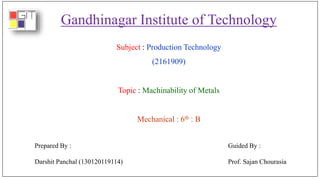2161909 130120119114
- 1. Gandhinagar Institute of Technology Subject : Production Technology (2161909) Topic : Machinability of Metals Mechanical : 6th : B Prepared By : Darshit Panchal (130120119114) Guided By : Prof. Sajan Chourasia
- 2. Machinability: ï§ Ease or difficulty with which metal can be machines ï§ Materials with good machinability require little power to cut, can be cut quickly, easily obtain a good finish, and do not wear the tooling much; such materials are said to be free machining.
- 3. Results of (Free Machining) Modifications: ï§ Three main machining characteristics become evident - Tool life is increased - Better surface finish produced - Lower power consumption required for machining
- 4. Grain Structure: ï§ Machinability of metal affected by its microstructure ï§ Ductility and shear strength modified greatly by operations such as annealing, normalizing and stress relieving ï§ Certain chemical and physical modifications of steel improve machinability - Addition of sulfur, lead, or sodium sulfite - Cold working, which modifies ductility
- 5. Low Carbon Steel: ï§ Large areas of ferrite interspersed with small areas of pearlite - Ferrite: soft, high ductility and low strength - Pearlite: low ductility and high strength âĒ Combination of ferrite and iron carbide ï§ More desirable microstructure in steel is when pearlite well distributed instead of in layers
- 6. High Carbon Steel: ï§ Greater amount of pearlite because of higher carbon content - More difficult to machine steel efficiently ï§ Desirable to anneal these steels to alter microstructures - Improves machining qualities
- 7. Alloy Steel: ï§ Combinations of two or more metals ï§ Generally slightly more difficult to machine than low-or high-carbon steels ï§ To improve machining qualities - Combinations of sulfur and lead or sulfur and manganese in proper proportions added - Combination of normalizing and annealing ï§ Machining of stainless steel greatly eased by addition of selenium
- 8. Cast Iron: ï§ Consists generally of ferrite, iron carbide, and free carbon ï§ Microstructure controlled by addition of alloys, method of casting, rate of cooling, and heat treating ï§ White cast iron cooled rapidly after casting - hard and brittle (formation of hard iron carbide) ï§ Gray cast iron cooled gradually - composed by compound pearlite, fine ferrite, iron carbide and flakes of graphite (softer)
- 9. Cast Iron: ï§ Machining slightly difficult due to iron carbide and presence of sand on outer surface of casting ï§ Microstructure altered through annealing - Iron carbide broken down into graphitic carbon and ferrite âĒ Easier to machine ï§ Addition of silicon, sulfur and manganese gives cast iron different qualities
- 10. Aluminum: ï§ Pure aluminum generally more difficult to machine than aluminum alloys - Produces long stringy chips and harder on cutting tool ï§ Aluminum alloys - Cut at high speeds, yield good surface finish - Hardened and tempered alloys easier to machine - Silicon in alloy makes it difficult to machine âĒ Chips tear from work (poor surface)
- 11. Copper: ï§ Heavy, soft, reddish-colored metal refined from copper ore (copper sulfide) - High electrical and thermal conductivity - Good corrosion resistance and strength - Easily welded, brazed or soldered - Very ductile ï§ Anneal: heat at 1200š F and quench in water ï§ Does not machine well: long chips clog flutes of cutting tool - Coolant should be used to minimize heat
- 12. Effects of Temperature & Friction: ï§ Heat created - Plastic deformation occurring in metal during process of forming chip - Friction created by chips sliding along cutting-tool face ï§ Cutting temperature varies with each metal and increases with cutting speed and rate of metal removal ï§ Greatest heat generated when ductile material of high tensile strength cut ï§ Lowest heat generated when soft material of low tensile strength cut ï§ Maximum temperature attained during cutting action - affects cutting-tool life, quality of surface finish, rate of production and accuracy of workpiece
- 13. Factors affecting surface Finish: ï§ Feed rate ï§ Nose radius of tool ï§ Cutting speed ï§ Temperature generated during machining process
- 14. Surface Finish: ï§ Direct relationship between temperature of workpiece and quality of surface finish - High temperature yields rough surface finish - Metal particles tend to adhere to cutting tool and form built-up edge ï§ Cooling work material reduces temperature of cutting-tool edge - Result in better surface finish
- 15. Effects of Cutting Fluids: ï§ Perform three important functions - Reduce temperature of cutting action - Reduce friction of chips sliding along tool face - Decrease tool wear and increase tool life ï§ Three types of cutting fluids - Cutting oils - Emulsifiable (soluble) oils - Chemical (synthetic) cutting fluids
- 16. Cutting Fluids: ï§ Generally used for machining steel, alloy steel, brass and bronze with high- speed steel cutting tools ï§ Not used with cemented-carbide tools âĒ If used, great quantities of cutting fluid are applied to ensure uniform temperatures to prevent carbide inserts from cracking ï§ Not generally used with cast iron, aluminum, and magnesium alloys âĒ Good results have been found in some cases
- 17. THANK YOU

















